Taxation Law Assignment: CGT, Depreciation, and Asset Valuation
VerifiedAdded on 2022/10/19
|10
|2220
|440
Homework Assignment
AI Summary
This document presents a comprehensive solution to a Taxation Law assignment, addressing two key issues: Capital Gains Tax (CGT) consequences and the determination of costs for depreciation calculations. The first part analyzes the CGT implications of various transactions undertaken by an individual named Jasmine, including the sale of a house, car, business, furniture, and paintings. It applies relevant sections of the Income Tax Assessment Act 1997 (ITAA 97) to determine taxable gains and losses, considering factors such as the main residence exemption, personal use assets, and collectables. The second part focuses on calculating the cost of a CNC machine for capital allowance purposes, determining the start time for depreciation, and applying relevant sections of the ITAA 97. It considers the various costs associated with acquiring and installing the machine, including purchase price, import costs, and installation expenses, to arrive at the depreciable cost. The solution provides a detailed breakdown of the applicable rules, their application to the facts, and the resulting tax outcomes.
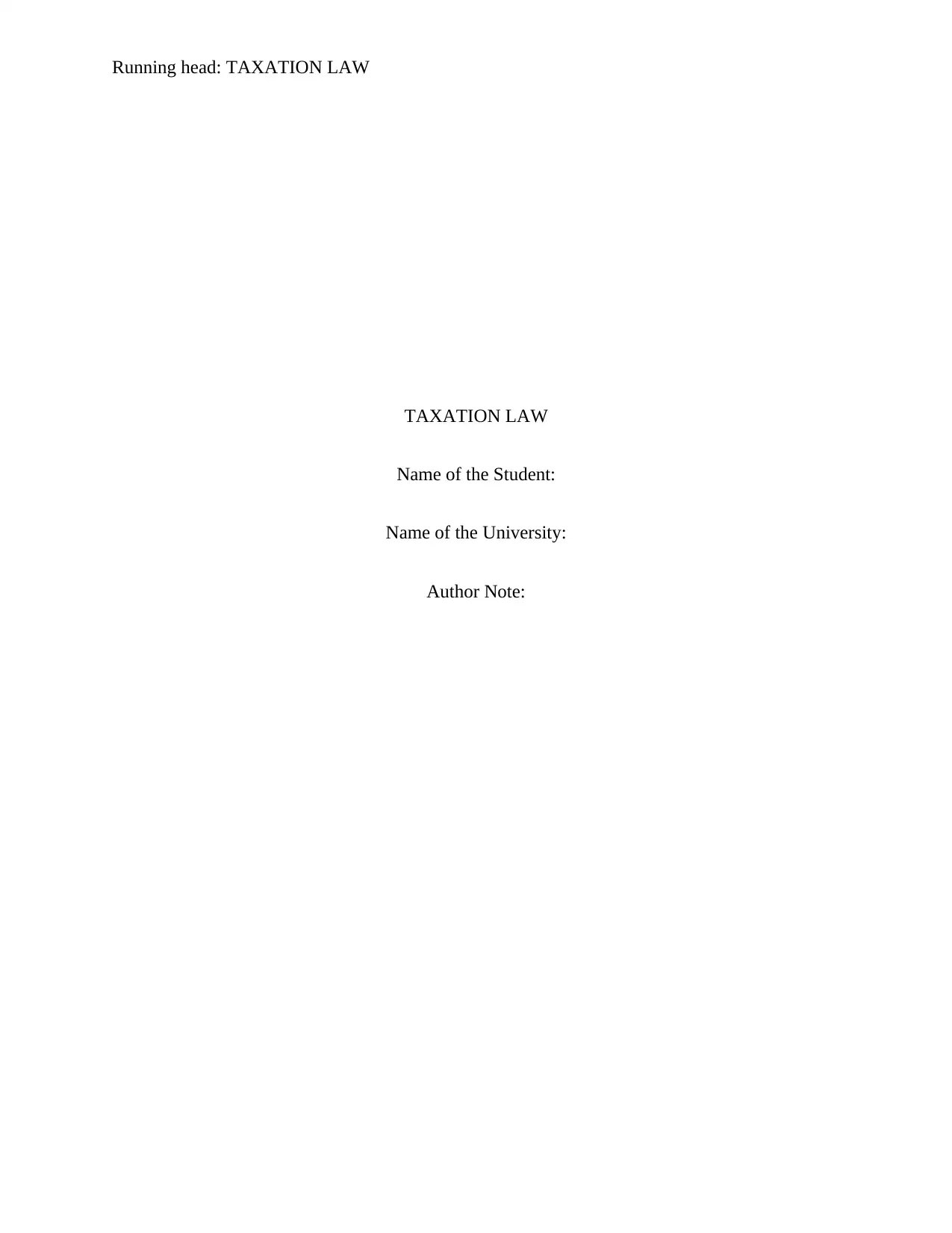
Running head: TAXATION LAW
TAXATION LAW
Name of the Student:
Name of the University:
Author Note:
TAXATION LAW
Name of the Student:
Name of the University:
Author Note:
Paraphrase This Document
Need a fresh take? Get an instant paraphrase of this document with our AI Paraphraser
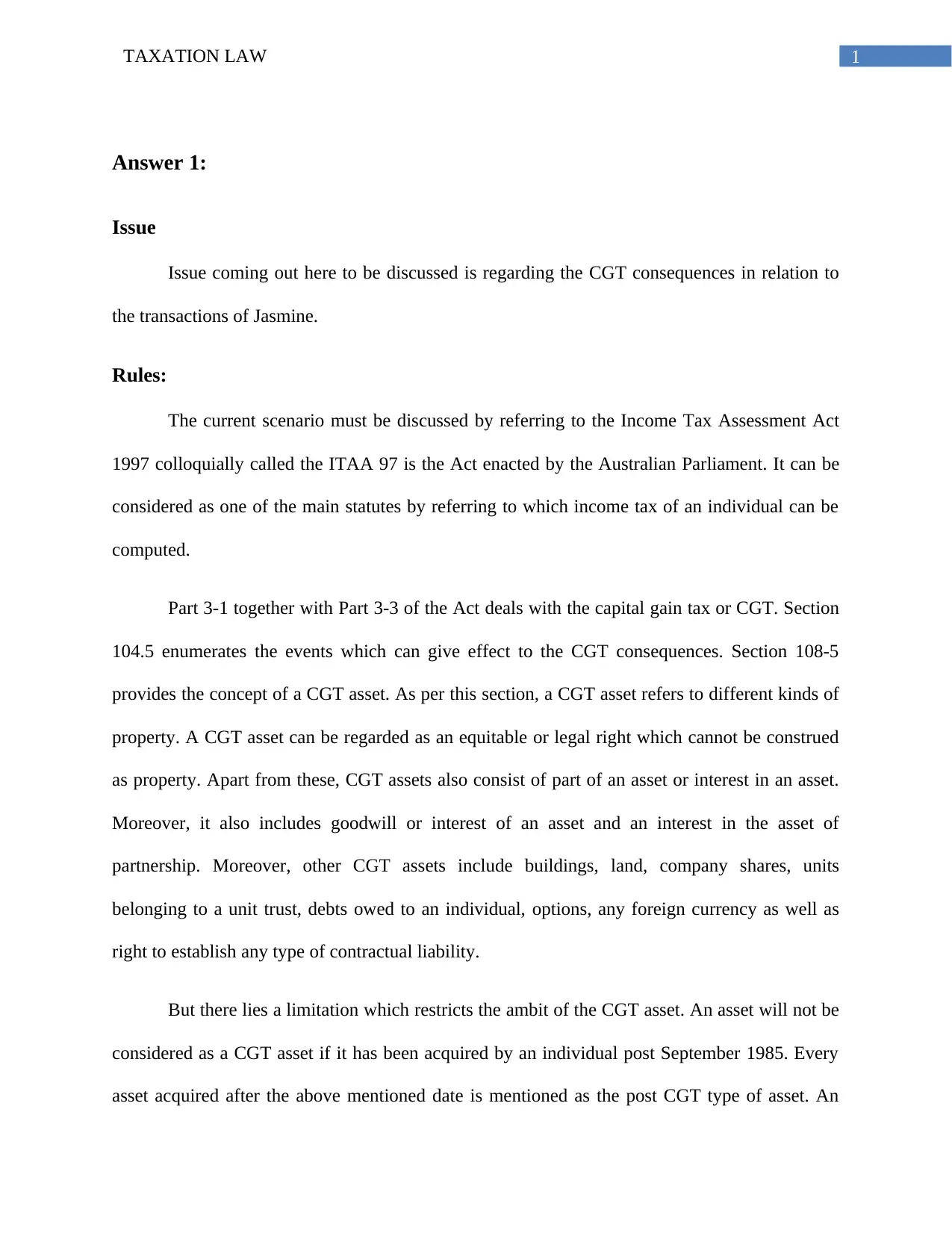
1TAXATION LAW
Answer 1:
Issue
Issue coming out here to be discussed is regarding the CGT consequences in relation to
the transactions of Jasmine.
Rules:
The current scenario must be discussed by referring to the Income Tax Assessment Act
1997 colloquially called the ITAA 97 is the Act enacted by the Australian Parliament. It can be
considered as one of the main statutes by referring to which income tax of an individual can be
computed.
Part 3-1 together with Part 3-3 of the Act deals with the capital gain tax or CGT. Section
104.5 enumerates the events which can give effect to the CGT consequences. Section 108-5
provides the concept of a CGT asset. As per this section, a CGT asset refers to different kinds of
property. A CGT asset can be regarded as an equitable or legal right which cannot be construed
as property. Apart from these, CGT assets also consist of part of an asset or interest in an asset.
Moreover, it also includes goodwill or interest of an asset and an interest in the asset of
partnership. Moreover, other CGT assets include buildings, land, company shares, units
belonging to a unit trust, debts owed to an individual, options, any foreign currency as well as
right to establish any type of contractual liability.
But there lies a limitation which restricts the ambit of the CGT asset. An asset will not be
considered as a CGT asset if it has been acquired by an individual post September 1985. Every
asset acquired after the above mentioned date is mentioned as the post CGT type of asset. An
Answer 1:
Issue
Issue coming out here to be discussed is regarding the CGT consequences in relation to
the transactions of Jasmine.
Rules:
The current scenario must be discussed by referring to the Income Tax Assessment Act
1997 colloquially called the ITAA 97 is the Act enacted by the Australian Parliament. It can be
considered as one of the main statutes by referring to which income tax of an individual can be
computed.
Part 3-1 together with Part 3-3 of the Act deals with the capital gain tax or CGT. Section
104.5 enumerates the events which can give effect to the CGT consequences. Section 108-5
provides the concept of a CGT asset. As per this section, a CGT asset refers to different kinds of
property. A CGT asset can be regarded as an equitable or legal right which cannot be construed
as property. Apart from these, CGT assets also consist of part of an asset or interest in an asset.
Moreover, it also includes goodwill or interest of an asset and an interest in the asset of
partnership. Moreover, other CGT assets include buildings, land, company shares, units
belonging to a unit trust, debts owed to an individual, options, any foreign currency as well as
right to establish any type of contractual liability.
But there lies a limitation which restricts the ambit of the CGT asset. An asset will not be
considered as a CGT asset if it has been acquired by an individual post September 1985. Every
asset acquired after the above mentioned date is mentioned as the post CGT type of asset. An
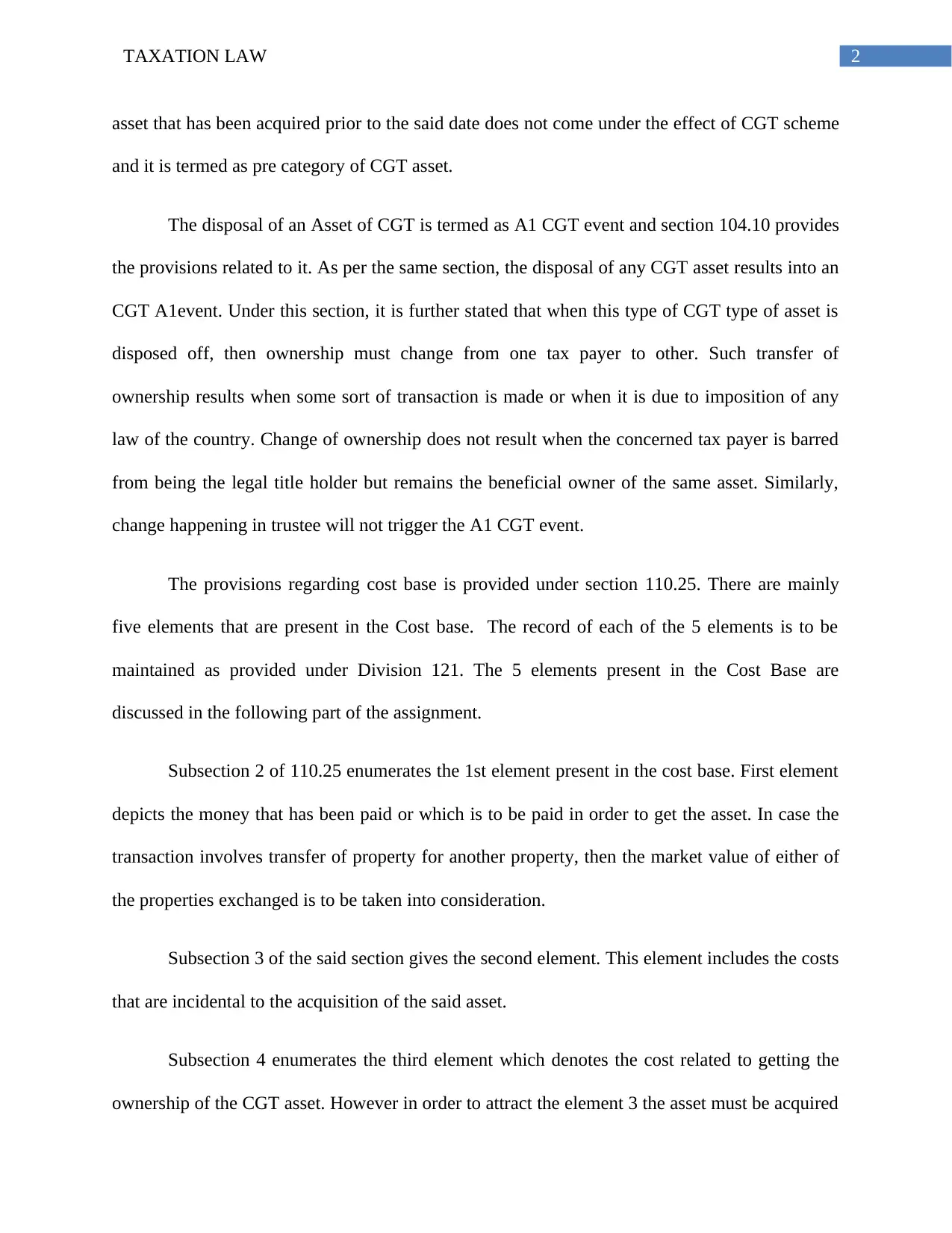
2TAXATION LAW
asset that has been acquired prior to the said date does not come under the effect of CGT scheme
and it is termed as pre category of CGT asset.
The disposal of an Asset of CGT is termed as A1 CGT event and section 104.10 provides
the provisions related to it. As per the same section, the disposal of any CGT asset results into an
CGT A1event. Under this section, it is further stated that when this type of CGT type of asset is
disposed off, then ownership must change from one tax payer to other. Such transfer of
ownership results when some sort of transaction is made or when it is due to imposition of any
law of the country. Change of ownership does not result when the concerned tax payer is barred
from being the legal title holder but remains the beneficial owner of the same asset. Similarly,
change happening in trustee will not trigger the A1 CGT event.
The provisions regarding cost base is provided under section 110.25. There are mainly
five elements that are present in the Cost base. The record of each of the 5 elements is to be
maintained as provided under Division 121. The 5 elements present in the Cost Base are
discussed in the following part of the assignment.
Subsection 2 of 110.25 enumerates the 1st element present in the cost base. First element
depicts the money that has been paid or which is to be paid in order to get the asset. In case the
transaction involves transfer of property for another property, then the market value of either of
the properties exchanged is to be taken into consideration.
Subsection 3 of the said section gives the second element. This element includes the costs
that are incidental to the acquisition of the said asset.
Subsection 4 enumerates the third element which denotes the cost related to getting the
ownership of the CGT asset. However in order to attract the element 3 the asset must be acquired
asset that has been acquired prior to the said date does not come under the effect of CGT scheme
and it is termed as pre category of CGT asset.
The disposal of an Asset of CGT is termed as A1 CGT event and section 104.10 provides
the provisions related to it. As per the same section, the disposal of any CGT asset results into an
CGT A1event. Under this section, it is further stated that when this type of CGT type of asset is
disposed off, then ownership must change from one tax payer to other. Such transfer of
ownership results when some sort of transaction is made or when it is due to imposition of any
law of the country. Change of ownership does not result when the concerned tax payer is barred
from being the legal title holder but remains the beneficial owner of the same asset. Similarly,
change happening in trustee will not trigger the A1 CGT event.
The provisions regarding cost base is provided under section 110.25. There are mainly
five elements that are present in the Cost base. The record of each of the 5 elements is to be
maintained as provided under Division 121. The 5 elements present in the Cost Base are
discussed in the following part of the assignment.
Subsection 2 of 110.25 enumerates the 1st element present in the cost base. First element
depicts the money that has been paid or which is to be paid in order to get the asset. In case the
transaction involves transfer of property for another property, then the market value of either of
the properties exchanged is to be taken into consideration.
Subsection 3 of the said section gives the second element. This element includes the costs
that are incidental to the acquisition of the said asset.
Subsection 4 enumerates the third element which denotes the cost related to getting the
ownership of the CGT asset. However in order to attract the element 3 the asset must be acquired
⊘ This is a preview!⊘
Do you want full access?
Subscribe today to unlock all pages.

Trusted by 1+ million students worldwide
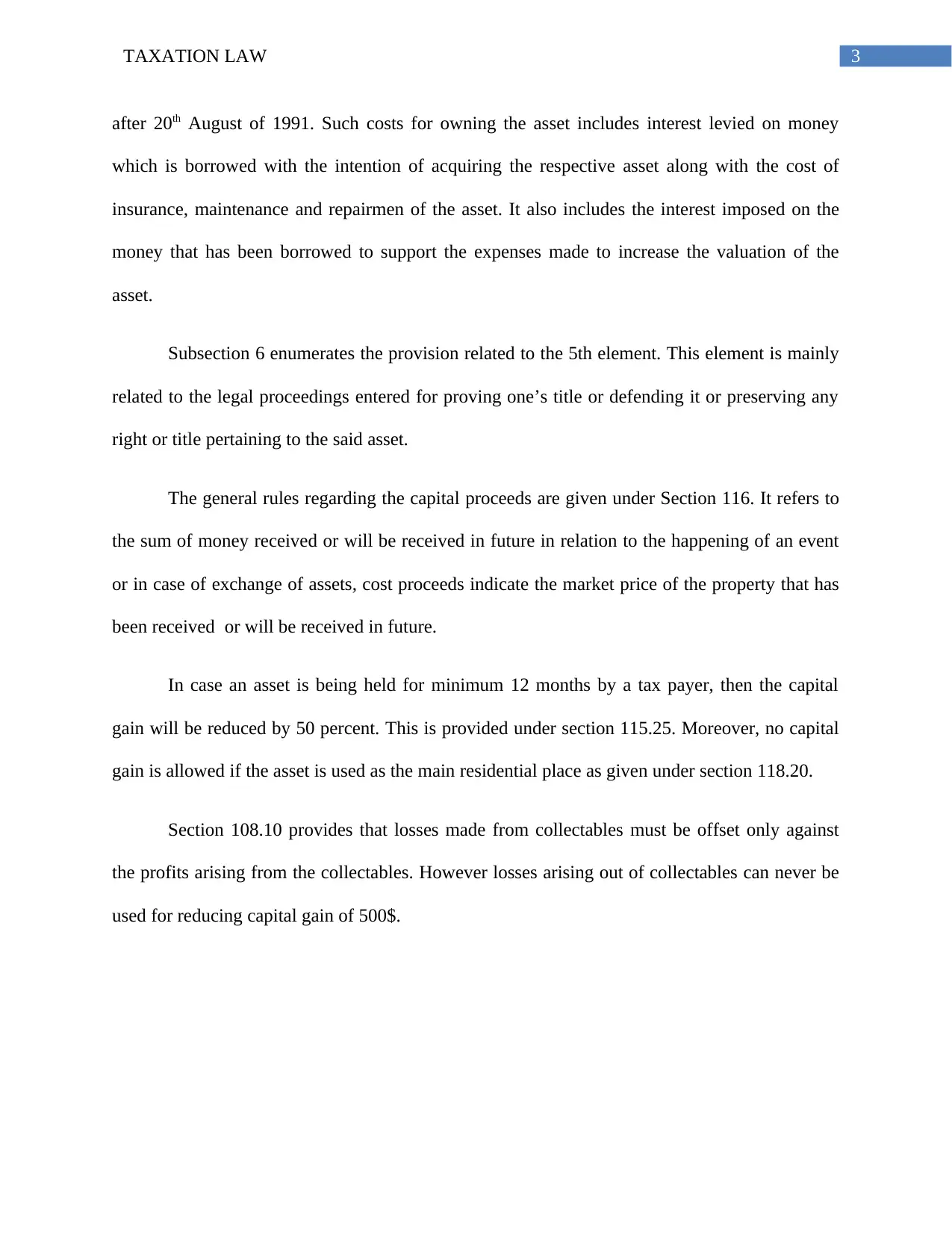
3TAXATION LAW
after 20th August of 1991. Such costs for owning the asset includes interest levied on money
which is borrowed with the intention of acquiring the respective asset along with the cost of
insurance, maintenance and repairmen of the asset. It also includes the interest imposed on the
money that has been borrowed to support the expenses made to increase the valuation of the
asset.
Subsection 6 enumerates the provision related to the 5th element. This element is mainly
related to the legal proceedings entered for proving one’s title or defending it or preserving any
right or title pertaining to the said asset.
The general rules regarding the capital proceeds are given under Section 116. It refers to
the sum of money received or will be received in future in relation to the happening of an event
or in case of exchange of assets, cost proceeds indicate the market price of the property that has
been received or will be received in future.
In case an asset is being held for minimum 12 months by a tax payer, then the capital
gain will be reduced by 50 percent. This is provided under section 115.25. Moreover, no capital
gain is allowed if the asset is used as the main residential place as given under section 118.20.
Section 108.10 provides that losses made from collectables must be offset only against
the profits arising from the collectables. However losses arising out of collectables can never be
used for reducing capital gain of 500$.
after 20th August of 1991. Such costs for owning the asset includes interest levied on money
which is borrowed with the intention of acquiring the respective asset along with the cost of
insurance, maintenance and repairmen of the asset. It also includes the interest imposed on the
money that has been borrowed to support the expenses made to increase the valuation of the
asset.
Subsection 6 enumerates the provision related to the 5th element. This element is mainly
related to the legal proceedings entered for proving one’s title or defending it or preserving any
right or title pertaining to the said asset.
The general rules regarding the capital proceeds are given under Section 116. It refers to
the sum of money received or will be received in future in relation to the happening of an event
or in case of exchange of assets, cost proceeds indicate the market price of the property that has
been received or will be received in future.
In case an asset is being held for minimum 12 months by a tax payer, then the capital
gain will be reduced by 50 percent. This is provided under section 115.25. Moreover, no capital
gain is allowed if the asset is used as the main residential place as given under section 118.20.
Section 108.10 provides that losses made from collectables must be offset only against
the profits arising from the collectables. However losses arising out of collectables can never be
used for reducing capital gain of 500$.
Paraphrase This Document
Need a fresh take? Get an instant paraphrase of this document with our AI Paraphraser
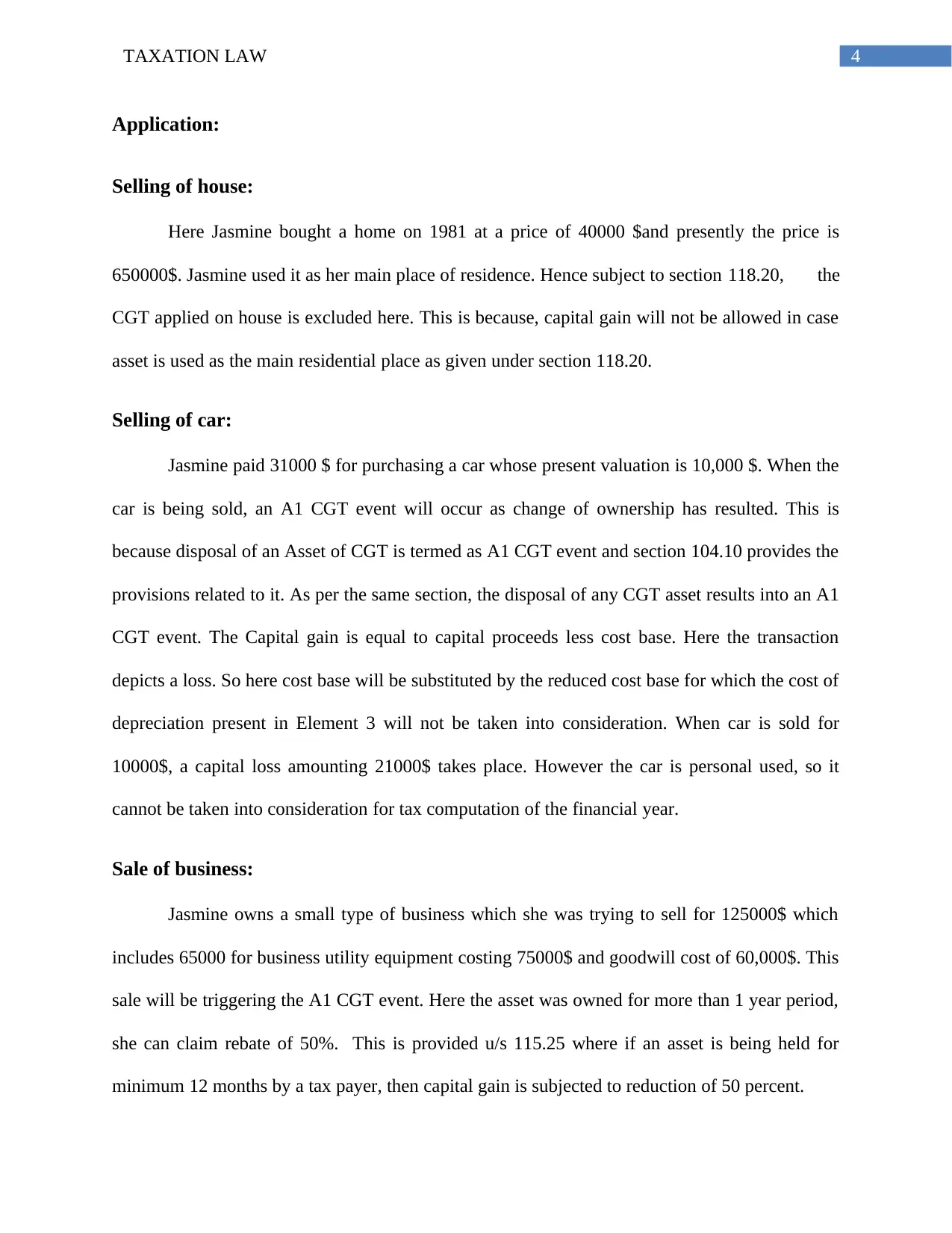
4TAXATION LAW
Application:
Selling of house:
Here Jasmine bought a home on 1981 at a price of 40000 $and presently the price is
650000$. Jasmine used it as her main place of residence. Hence subject to section 118.20, the
CGT applied on house is excluded here. This is because, capital gain will not be allowed in case
asset is used as the main residential place as given under section 118.20.
Selling of car:
Jasmine paid 31000 $ for purchasing a car whose present valuation is 10,000 $. When the
car is being sold, an A1 CGT event will occur as change of ownership has resulted. This is
because disposal of an Asset of CGT is termed as A1 CGT event and section 104.10 provides the
provisions related to it. As per the same section, the disposal of any CGT asset results into an A1
CGT event. The Capital gain is equal to capital proceeds less cost base. Here the transaction
depicts a loss. So here cost base will be substituted by the reduced cost base for which the cost of
depreciation present in Element 3 will not be taken into consideration. When car is sold for
10000$, a capital loss amounting 21000$ takes place. However the car is personal used, so it
cannot be taken into consideration for tax computation of the financial year.
Sale of business:
Jasmine owns a small type of business which she was trying to sell for 125000$ which
includes 65000 for business utility equipment costing 75000$ and goodwill cost of 60,000$. This
sale will be triggering the A1 CGT event. Here the asset was owned for more than 1 year period,
she can claim rebate of 50%. This is provided u/s 115.25 where if an asset is being held for
minimum 12 months by a tax payer, then capital gain is subjected to reduction of 50 percent.
Application:
Selling of house:
Here Jasmine bought a home on 1981 at a price of 40000 $and presently the price is
650000$. Jasmine used it as her main place of residence. Hence subject to section 118.20, the
CGT applied on house is excluded here. This is because, capital gain will not be allowed in case
asset is used as the main residential place as given under section 118.20.
Selling of car:
Jasmine paid 31000 $ for purchasing a car whose present valuation is 10,000 $. When the
car is being sold, an A1 CGT event will occur as change of ownership has resulted. This is
because disposal of an Asset of CGT is termed as A1 CGT event and section 104.10 provides the
provisions related to it. As per the same section, the disposal of any CGT asset results into an A1
CGT event. The Capital gain is equal to capital proceeds less cost base. Here the transaction
depicts a loss. So here cost base will be substituted by the reduced cost base for which the cost of
depreciation present in Element 3 will not be taken into consideration. When car is sold for
10000$, a capital loss amounting 21000$ takes place. However the car is personal used, so it
cannot be taken into consideration for tax computation of the financial year.
Sale of business:
Jasmine owns a small type of business which she was trying to sell for 125000$ which
includes 65000 for business utility equipment costing 75000$ and goodwill cost of 60,000$. This
sale will be triggering the A1 CGT event. Here the asset was owned for more than 1 year period,
she can claim rebate of 50%. This is provided u/s 115.25 where if an asset is being held for
minimum 12 months by a tax payer, then capital gain is subjected to reduction of 50 percent.
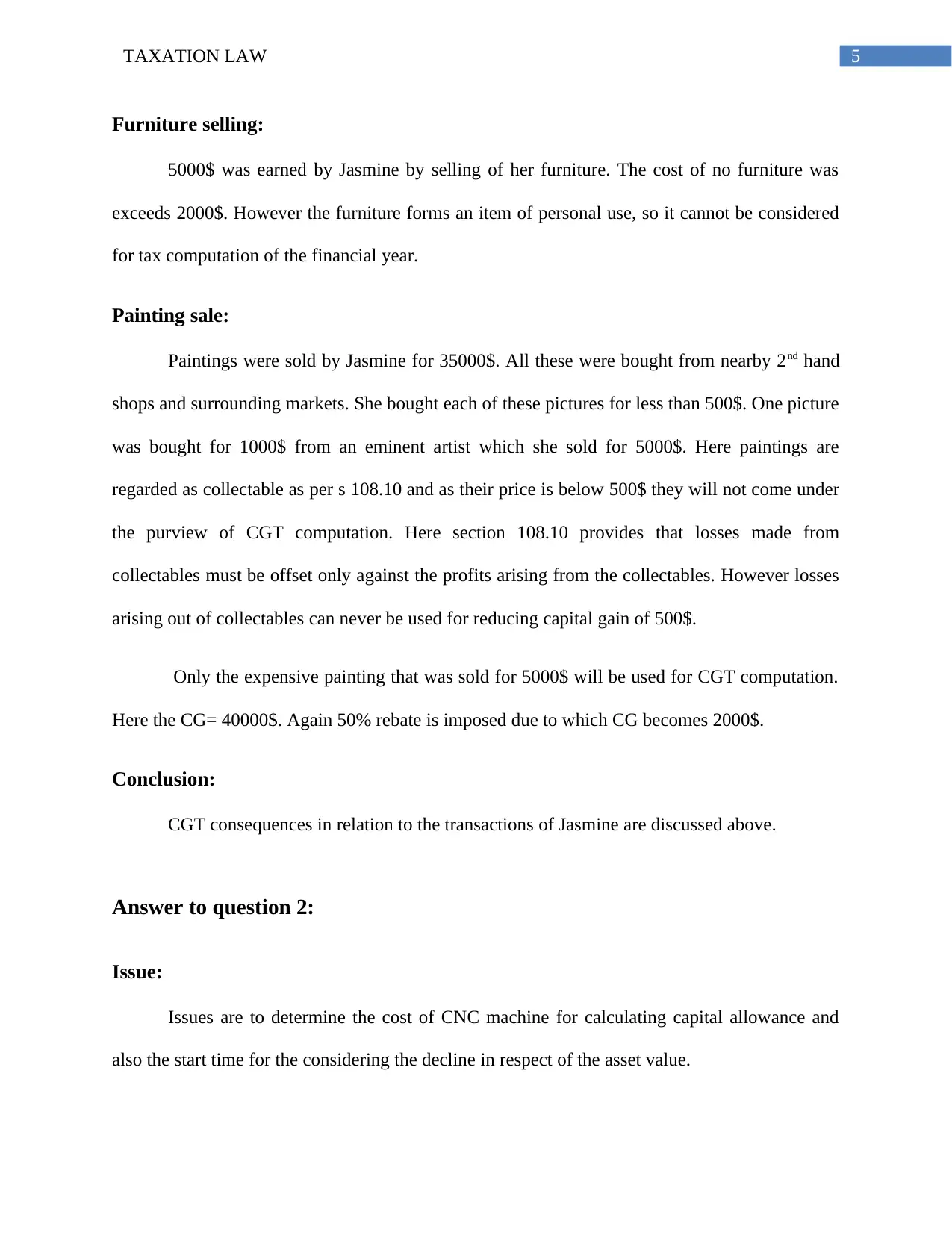
5TAXATION LAW
Furniture selling:
5000$ was earned by Jasmine by selling of her furniture. The cost of no furniture was
exceeds 2000$. However the furniture forms an item of personal use, so it cannot be considered
for tax computation of the financial year.
Painting sale:
Paintings were sold by Jasmine for 35000$. All these were bought from nearby 2nd hand
shops and surrounding markets. She bought each of these pictures for less than 500$. One picture
was bought for 1000$ from an eminent artist which she sold for 5000$. Here paintings are
regarded as collectable as per s 108.10 and as their price is below 500$ they will not come under
the purview of CGT computation. Here section 108.10 provides that losses made from
collectables must be offset only against the profits arising from the collectables. However losses
arising out of collectables can never be used for reducing capital gain of 500$.
Only the expensive painting that was sold for 5000$ will be used for CGT computation.
Here the CG= 40000$. Again 50% rebate is imposed due to which CG becomes 2000$.
Conclusion:
CGT consequences in relation to the transactions of Jasmine are discussed above.
Answer to question 2:
Issue:
Issues are to determine the cost of CNC machine for calculating capital allowance and
also the start time for the considering the decline in respect of the asset value.
Furniture selling:
5000$ was earned by Jasmine by selling of her furniture. The cost of no furniture was
exceeds 2000$. However the furniture forms an item of personal use, so it cannot be considered
for tax computation of the financial year.
Painting sale:
Paintings were sold by Jasmine for 35000$. All these were bought from nearby 2nd hand
shops and surrounding markets. She bought each of these pictures for less than 500$. One picture
was bought for 1000$ from an eminent artist which she sold for 5000$. Here paintings are
regarded as collectable as per s 108.10 and as their price is below 500$ they will not come under
the purview of CGT computation. Here section 108.10 provides that losses made from
collectables must be offset only against the profits arising from the collectables. However losses
arising out of collectables can never be used for reducing capital gain of 500$.
Only the expensive painting that was sold for 5000$ will be used for CGT computation.
Here the CG= 40000$. Again 50% rebate is imposed due to which CG becomes 2000$.
Conclusion:
CGT consequences in relation to the transactions of Jasmine are discussed above.
Answer to question 2:
Issue:
Issues are to determine the cost of CNC machine for calculating capital allowance and
also the start time for the considering the decline in respect of the asset value.
⊘ This is a preview!⊘
Do you want full access?
Subscribe today to unlock all pages.

Trusted by 1+ million students worldwide
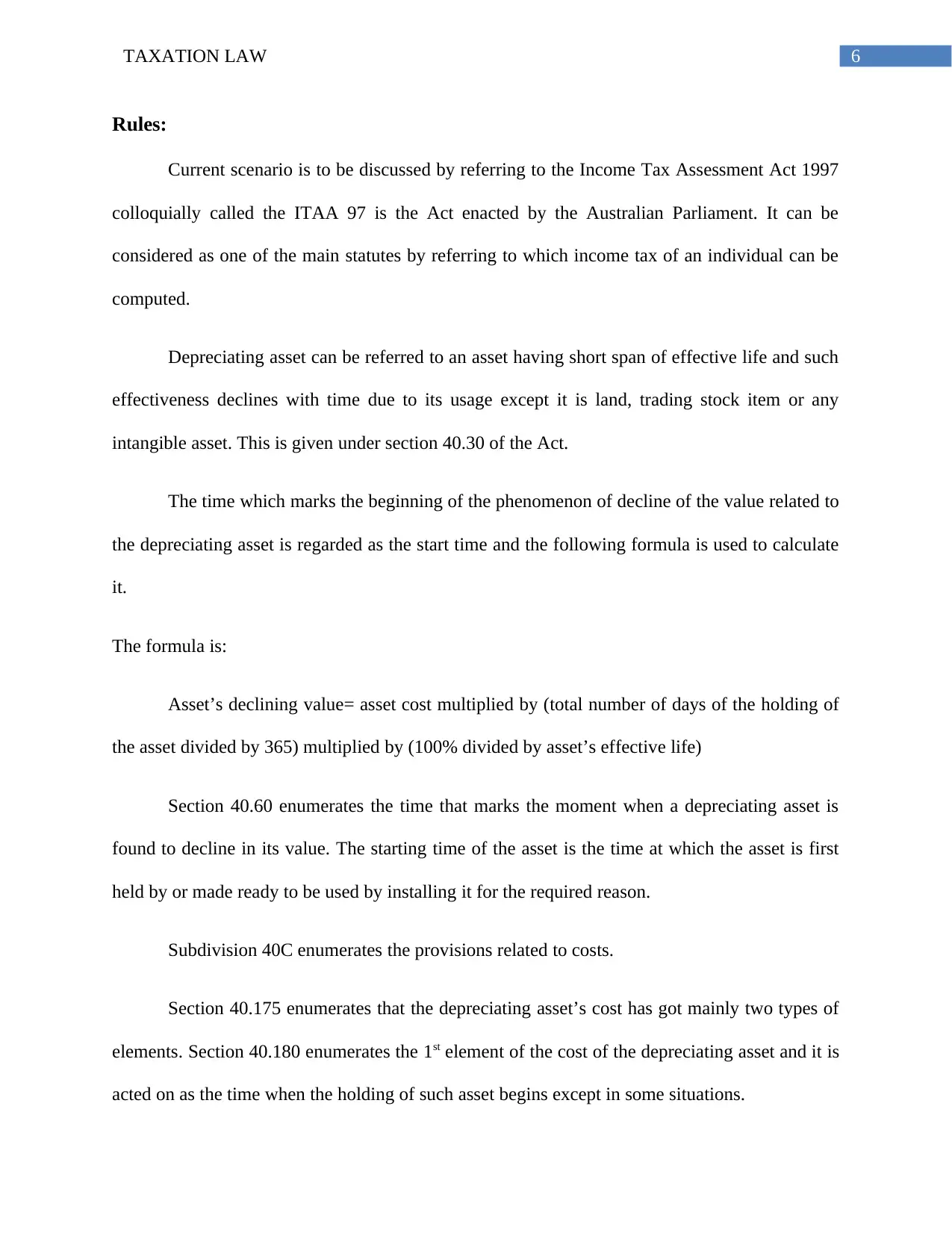
6TAXATION LAW
Rules:
Current scenario is to be discussed by referring to the Income Tax Assessment Act 1997
colloquially called the ITAA 97 is the Act enacted by the Australian Parliament. It can be
considered as one of the main statutes by referring to which income tax of an individual can be
computed.
Depreciating asset can be referred to an asset having short span of effective life and such
effectiveness declines with time due to its usage except it is land, trading stock item or any
intangible asset. This is given under section 40.30 of the Act.
The time which marks the beginning of the phenomenon of decline of the value related to
the depreciating asset is regarded as the start time and the following formula is used to calculate
it.
The formula is:
Asset’s declining value= asset cost multiplied by (total number of days of the holding of
the asset divided by 365) multiplied by (100% divided by asset’s effective life)
Section 40.60 enumerates the time that marks the moment when a depreciating asset is
found to decline in its value. The starting time of the asset is the time at which the asset is first
held by or made ready to be used by installing it for the required reason.
Subdivision 40C enumerates the provisions related to costs.
Section 40.175 enumerates that the depreciating asset’s cost has got mainly two types of
elements. Section 40.180 enumerates the 1st element of the cost of the depreciating asset and it is
acted on as the time when the holding of such asset begins except in some situations.
Rules:
Current scenario is to be discussed by referring to the Income Tax Assessment Act 1997
colloquially called the ITAA 97 is the Act enacted by the Australian Parliament. It can be
considered as one of the main statutes by referring to which income tax of an individual can be
computed.
Depreciating asset can be referred to an asset having short span of effective life and such
effectiveness declines with time due to its usage except it is land, trading stock item or any
intangible asset. This is given under section 40.30 of the Act.
The time which marks the beginning of the phenomenon of decline of the value related to
the depreciating asset is regarded as the start time and the following formula is used to calculate
it.
The formula is:
Asset’s declining value= asset cost multiplied by (total number of days of the holding of
the asset divided by 365) multiplied by (100% divided by asset’s effective life)
Section 40.60 enumerates the time that marks the moment when a depreciating asset is
found to decline in its value. The starting time of the asset is the time at which the asset is first
held by or made ready to be used by installing it for the required reason.
Subdivision 40C enumerates the provisions related to costs.
Section 40.175 enumerates that the depreciating asset’s cost has got mainly two types of
elements. Section 40.180 enumerates the 1st element of the cost of the depreciating asset and it is
acted on as the time when the holding of such asset begins except in some situations.
Paraphrase This Document
Need a fresh take? Get an instant paraphrase of this document with our AI Paraphraser
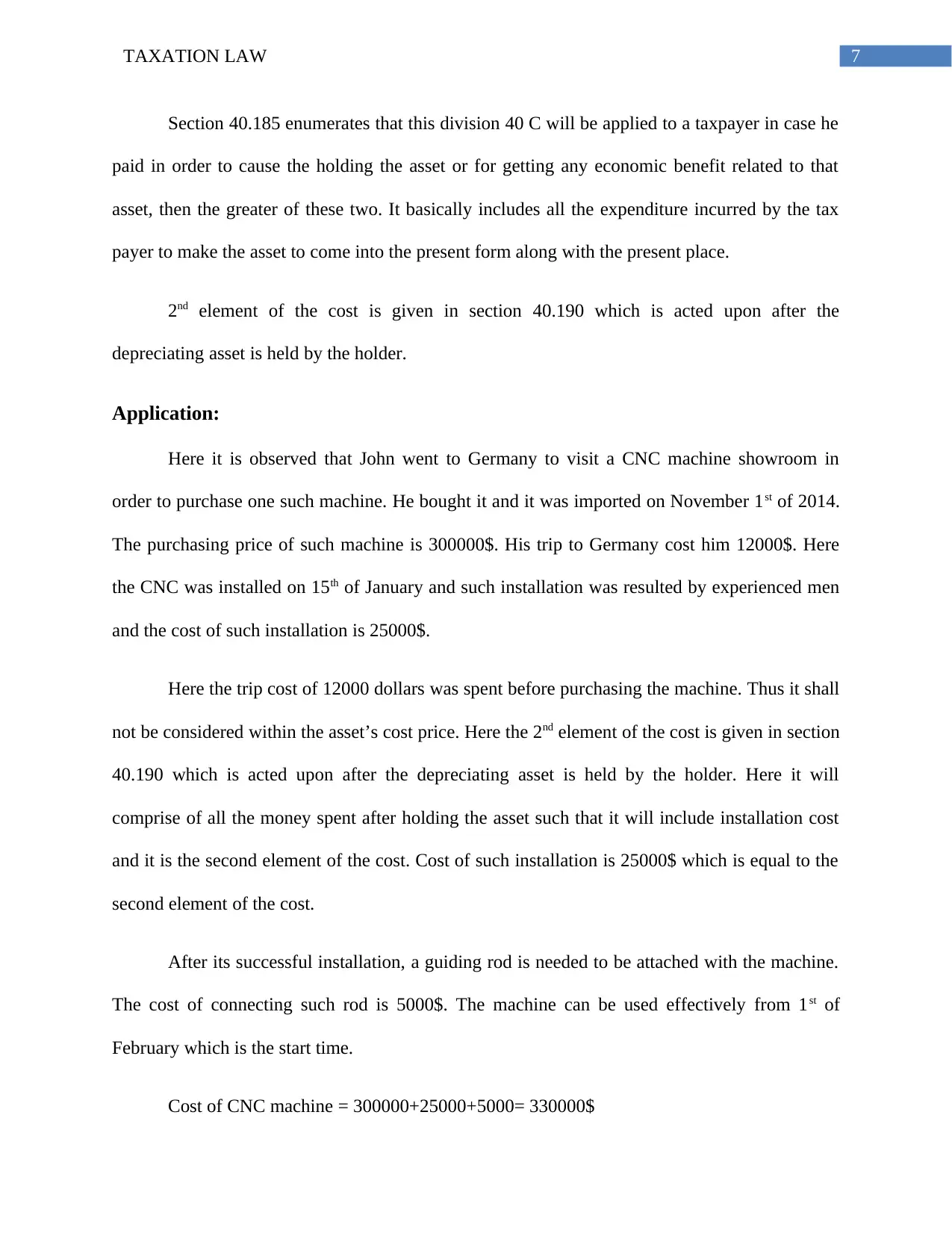
7TAXATION LAW
Section 40.185 enumerates that this division 40 C will be applied to a taxpayer in case he
paid in order to cause the holding the asset or for getting any economic benefit related to that
asset, then the greater of these two. It basically includes all the expenditure incurred by the tax
payer to make the asset to come into the present form along with the present place.
2nd element of the cost is given in section 40.190 which is acted upon after the
depreciating asset is held by the holder.
Application:
Here it is observed that John went to Germany to visit a CNC machine showroom in
order to purchase one such machine. He bought it and it was imported on November 1st of 2014.
The purchasing price of such machine is 300000$. His trip to Germany cost him 12000$. Here
the CNC was installed on 15th of January and such installation was resulted by experienced men
and the cost of such installation is 25000$.
Here the trip cost of 12000 dollars was spent before purchasing the machine. Thus it shall
not be considered within the asset’s cost price. Here the 2nd element of the cost is given in section
40.190 which is acted upon after the depreciating asset is held by the holder. Here it will
comprise of all the money spent after holding the asset such that it will include installation cost
and it is the second element of the cost. Cost of such installation is 25000$ which is equal to the
second element of the cost.
After its successful installation, a guiding rod is needed to be attached with the machine.
The cost of connecting such rod is 5000$. The machine can be used effectively from 1st of
February which is the start time.
Cost of CNC machine = 300000+25000+5000= 330000$
Section 40.185 enumerates that this division 40 C will be applied to a taxpayer in case he
paid in order to cause the holding the asset or for getting any economic benefit related to that
asset, then the greater of these two. It basically includes all the expenditure incurred by the tax
payer to make the asset to come into the present form along with the present place.
2nd element of the cost is given in section 40.190 which is acted upon after the
depreciating asset is held by the holder.
Application:
Here it is observed that John went to Germany to visit a CNC machine showroom in
order to purchase one such machine. He bought it and it was imported on November 1st of 2014.
The purchasing price of such machine is 300000$. His trip to Germany cost him 12000$. Here
the CNC was installed on 15th of January and such installation was resulted by experienced men
and the cost of such installation is 25000$.
Here the trip cost of 12000 dollars was spent before purchasing the machine. Thus it shall
not be considered within the asset’s cost price. Here the 2nd element of the cost is given in section
40.190 which is acted upon after the depreciating asset is held by the holder. Here it will
comprise of all the money spent after holding the asset such that it will include installation cost
and it is the second element of the cost. Cost of such installation is 25000$ which is equal to the
second element of the cost.
After its successful installation, a guiding rod is needed to be attached with the machine.
The cost of connecting such rod is 5000$. The machine can be used effectively from 1st of
February which is the start time.
Cost of CNC machine = 300000+25000+5000= 330000$
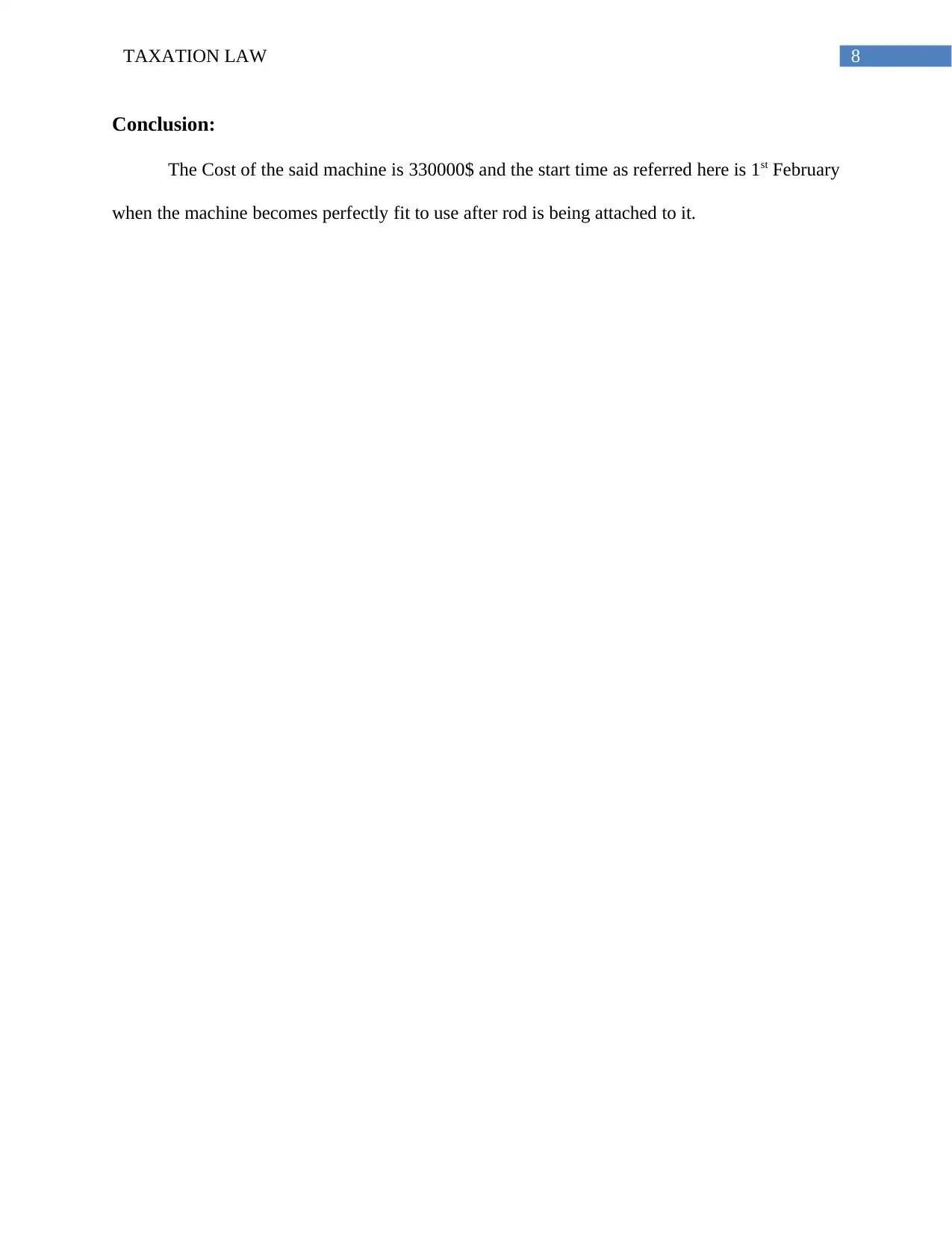
8TAXATION LAW
Conclusion:
The Cost of the said machine is 330000$ and the start time as referred here is 1st February
when the machine becomes perfectly fit to use after rod is being attached to it.
Conclusion:
The Cost of the said machine is 330000$ and the start time as referred here is 1st February
when the machine becomes perfectly fit to use after rod is being attached to it.
⊘ This is a preview!⊘
Do you want full access?
Subscribe today to unlock all pages.

Trusted by 1+ million students worldwide
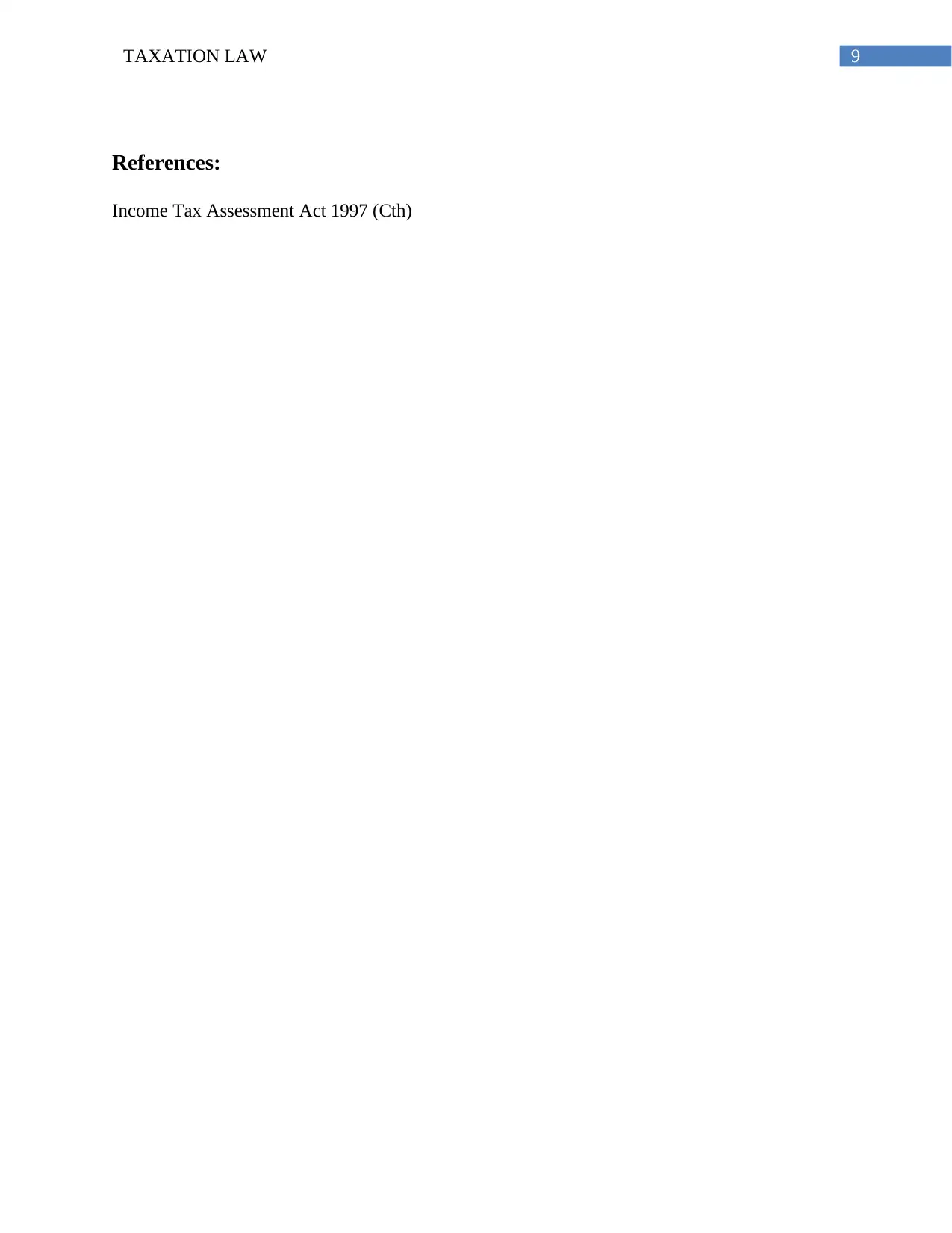
9TAXATION LAW
References:
Income Tax Assessment Act 1997 (Cth)
References:
Income Tax Assessment Act 1997 (Cth)
1 out of 10
Related Documents
Your All-in-One AI-Powered Toolkit for Academic Success.
+13062052269
info@desklib.com
Available 24*7 on WhatsApp / Email
![[object Object]](/_next/static/media/star-bottom.7253800d.svg)
Unlock your academic potential
Copyright © 2020–2025 A2Z Services. All Rights Reserved. Developed and managed by ZUCOL.





